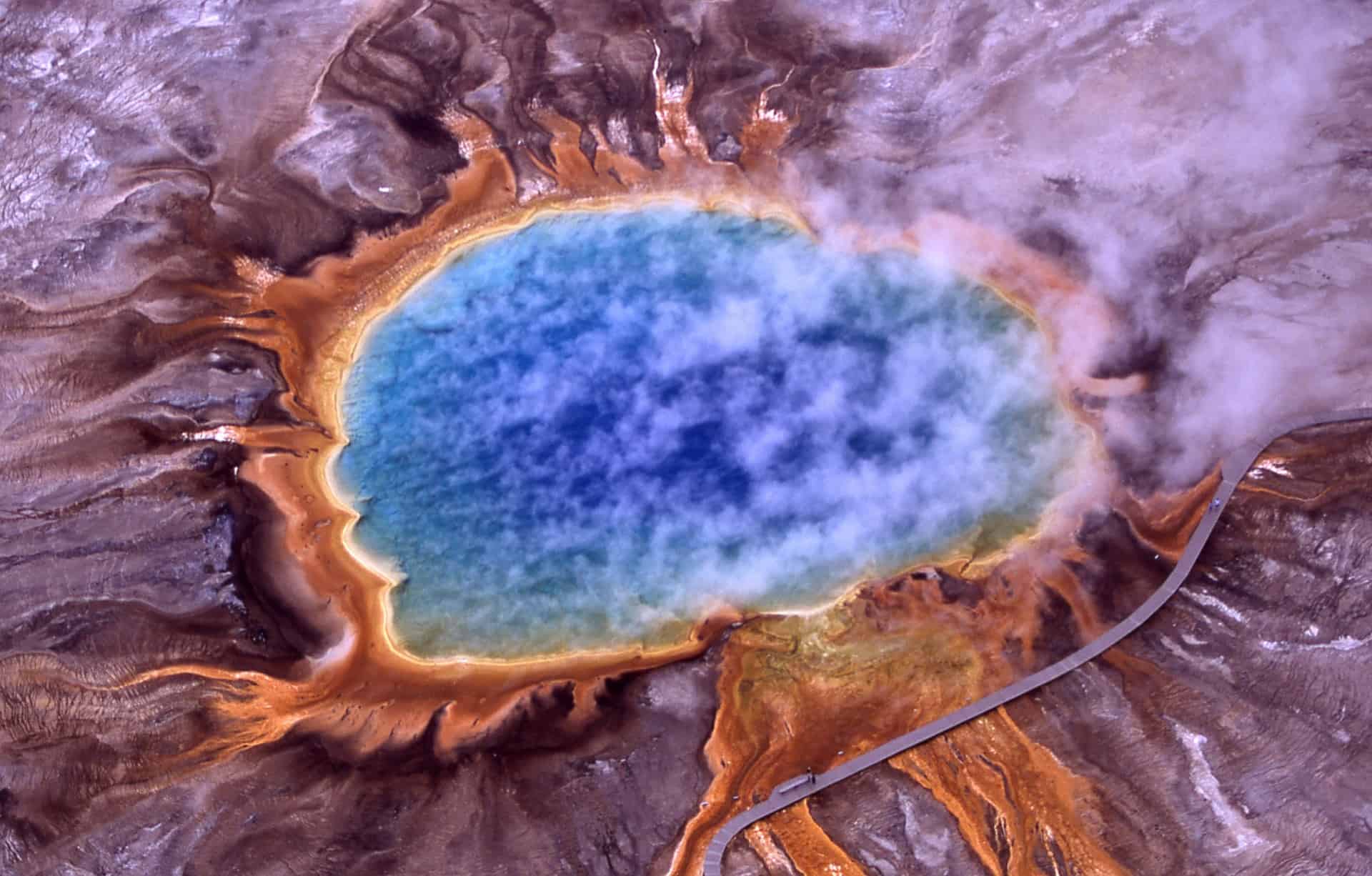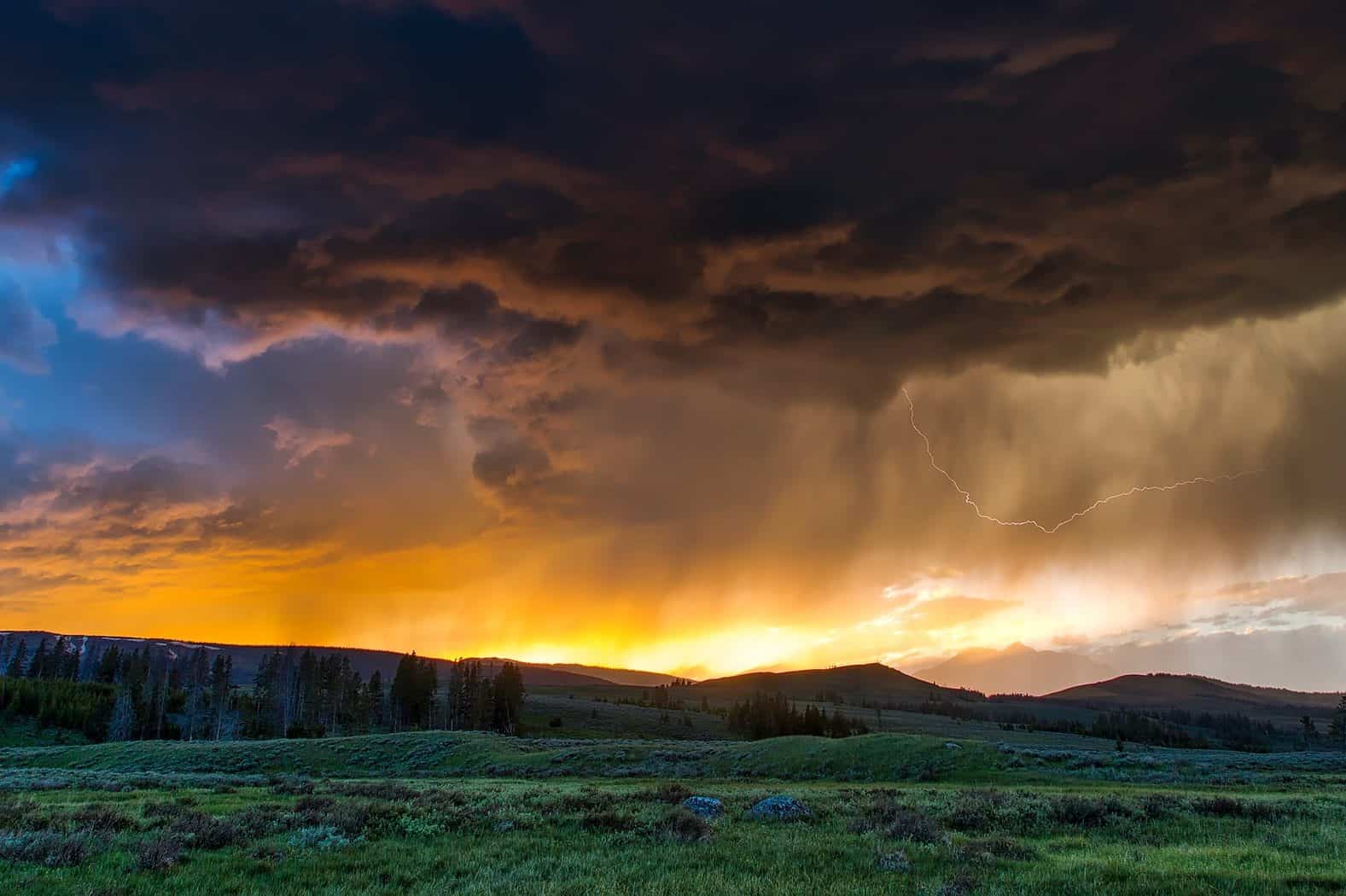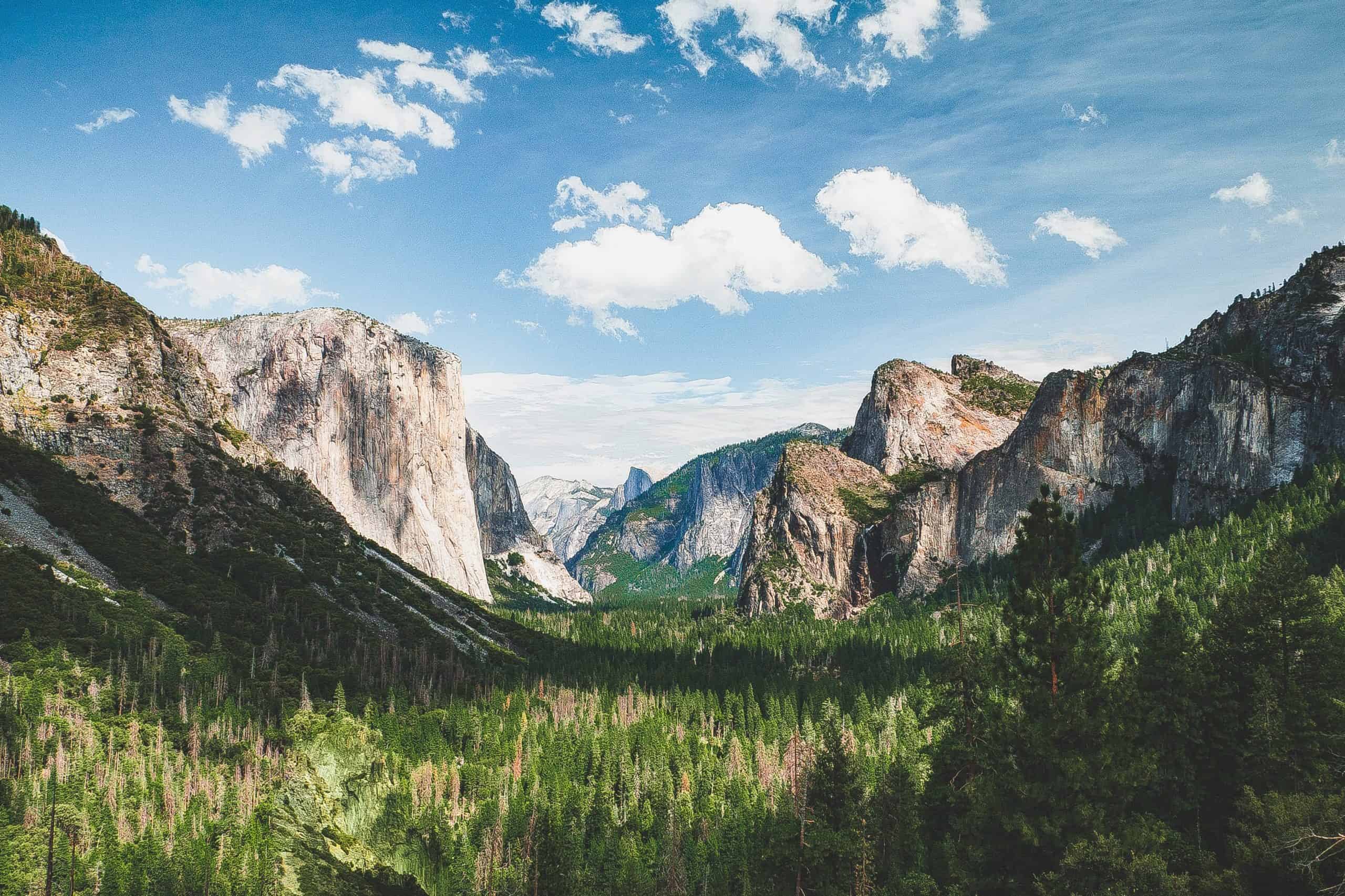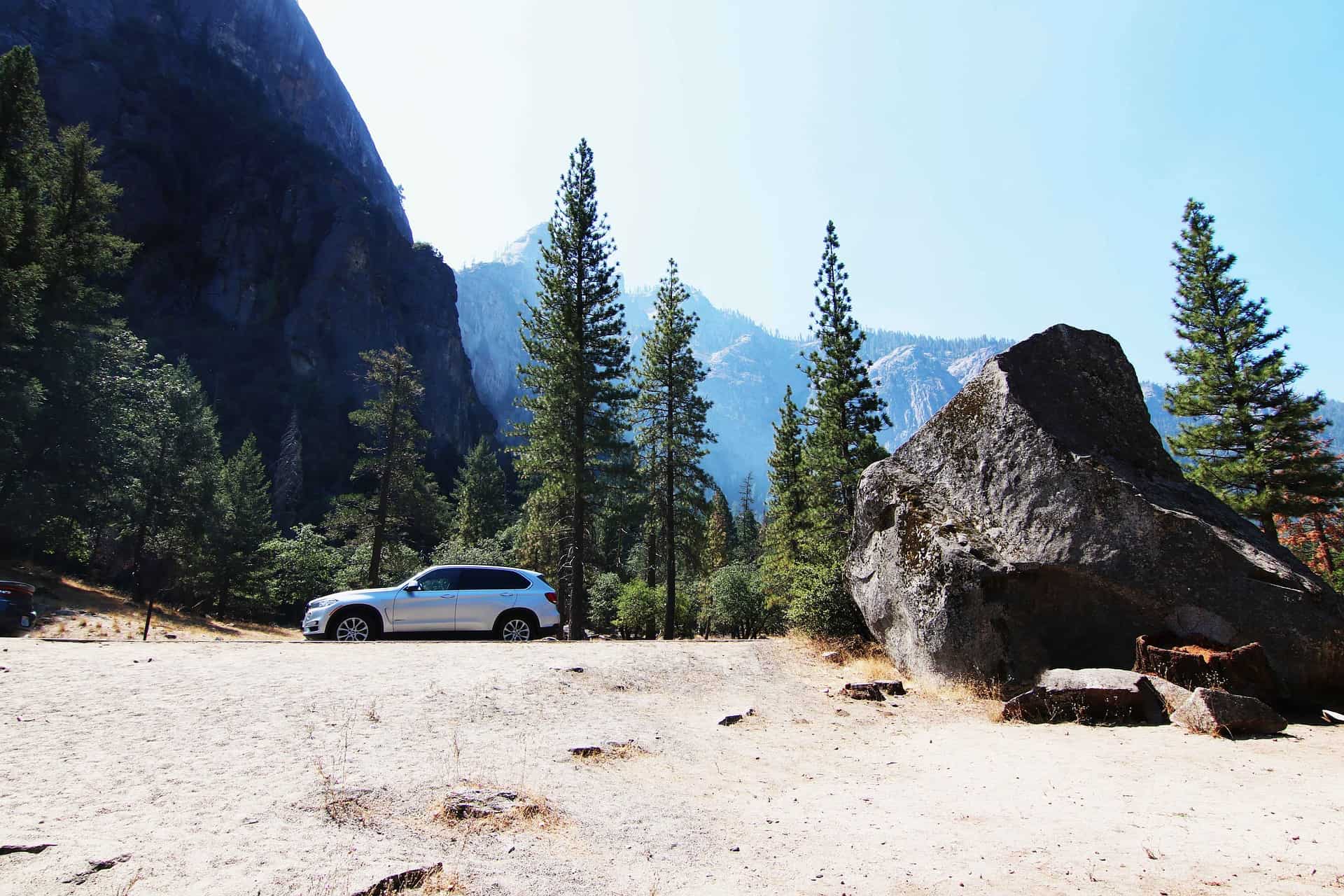The National Parks system hosts amazing attractions across the United States. Yosemite and Yellowstone National Parks are both remarkable places for any nature lover or history connoisseur. These parks offer what seems like endless expanses of trails, sightseeing, mountains, and waterfalls, but they are not entirely the same.
Here are the six major differences between Yosemite vs. Yellowstone:
| Major Differences | Yosemite National Park | Yellowstone National Park |
| Size | 1,187 square miles | 3,742 square miles |
| Attractions | 10 main attractions | 6 main attractions |
| Wildlife | Five unique mammals and birds | Six unique mammals and birds |
| Weather | Colder and has a longer snow season; summer sees more consistent warm temperatures during the day | Less drastic weather changes due to more even elevation; snow and rain are common throughout the winter, spring, and fall seasons |
| Geography | Sierra Nevada Mountains; Glacier-based attractions | Rocky Mountains; Geothermal-based attractions |
| Tourism | Central location near major cities and not far from the ocean; more than 4 million tourists per year | Remote location; still sees over 4 million people annually |
In this post, you will learn all you need to know about Yellowstone vs. Yosemite. I will discuss the differences between the two parks and their history, along with the best way to travel to these parks and how in certain scenarios, you may prefer to visit Yellowstone instead of the superior choice, Yosemite.
What are the Differences Between Yosemite and Yellowstone?
Both parks are breathtaking, but Yosemite offers superior lodging, tourist guidance, and opportunities to experience a range of nature’s wonders, all while big cities are close by. When visiting Yosemite, you get access to California’s breathtaking mountains, vast riverways, and beautiful forests.
Related: A Complete US National Park List
The Features of Yosemite National Park
Yosemite National Park offers proximity to big cities, fantastic nature trails, steep mountains, vast forests, enchanting waterfalls, and curious wildlife. These key features are what make up most of the park differences and set Yosemite apart from Yellowstone.
Yosemite has better lodging options because of its proximity to larger cities, which provides easy access to the park. Additionally, guides are available for all tourists, and information found throughout the park is clear and concise. Finally, being close to the city sets this national park apart. You get to experience the wonders of nature and return to city life in a few hours.
The Highlights of Yellowstone National Park
Yellowstone offers an off-road, rugged experience. In addition to waterfalls, Yellowstone offers geysers, another water feature that offers some microbial wonders. These geysers are home to thermophilic bacteria, which create beautiful, colorful landscapes. This is one of the most underrated parts of Yellowstone.
The second major difference is that Yellowstone has geothermal activity, which lends to the beautiful geysers. The land inside the park is part of a volcanic caldera. Some people refer to this as a supervolcano. The supervolcano is another major attraction of Yellowstone.
How Do Yosemite and Yellowstone Compare?

Aside from both being national parks, Yosemite and Yellowstone are very different. Yosemite National Park is better even though both parks have hundreds of thousands of visitors each year. However, you need to consider the differences between the parks before you plan your trip.
Size
Yosemite is smaller than Yellowstone (even though it is the park you should visit). Yellowstone is approximately 3,742 square miles. It spans three states: Wyoming, Montana, and Idaho. While Yosemite is only 1,187 square miles in comparison, 95% of the park is considered wilderness.
Yellowstone has many geographic and geologic sites that fall into its vast area:
- 500 geysers
- One caldera
- 290 waterfalls
- 900 historic buildings
- 1,800+ archeological sites
- Five park entrances
- 15 miles of boardwalk
- 466 miles of road
- 92 trailheads
Yosemite also has many geographic and geologic sites that fall within its park limits:
- 214 miles of road
- 20 miles of bike paths
- 849 buildings
- Two glaciers
- Countless waterfalls
Main Attractions
Each of the national parks has attractions that make it unique and worth experiencing. The main attractions at Yosemite vs. Yellowstone are very different and tend to draw different crowds. Both, however, are visited by millions of people each year.
Key places to visit at Yellowstone National Park are:
- Old Faithful
- Mammoth Hot Springs
- Grand Canyon of the Yellowstone River
- Norris Geyser Basin
- Mud Volcano
- Fountain Paint Pot Trail
Many of Yellowstone’s attractions are connected to its volcanic and geothermal activity. The geysers, hot springs, and volcanoes are all made possible by the caldera located within Yellowstone’s park limits.
The main attractions to visit at Yosemite National Park are:
- Mariposa Grove
- El Capitan
- Half Dome
- Tuolumne Meadows
- Crane Flat
- Yosemite Falls
- Horsetail Fall
- Hetch Hetchy Valley and Wapama Falls
- Sentinel Rock
- Glacier Point
Glaciers carved out most of the attractions at Yosemite millions of years ago. These glaciers created the large granite slabs and beautiful waterfalls seen throughout the park.
Be prepared when you are visiting these main attractions! I recommend bringing along a sturdy backpack, like the TETON Sports Oasis for your trip. It can be filled with snacks and other supplies for your short trail hikes. This backpack comes in multiple colors and is a comfortable, lightweight option.
Wildlife
One of the main attractions of national parks is their wildlife. Unique animals can be seen throughout the parks (at a safe distance, of course). Wildlife makes for great photographs and even more memorable moments.
Different types of wildlife at Yellowstone vs. Yosemite are shown in the chart below:
| Wildlife Found Only in Yellowstone National Park | Wildlife Found in Both National Parks | Wildlife Found Only in Yosemite National Park |
| Wolves, Bison, Lynxes, Badgers, Moose, Mountain Goats | Bears, Mountain Lions, Cougars Foxes, Big Horn Sheep, Elk, Deer, Bats, Owls, Eagles, Bobcats Coyotes, Wolverines River, Otters | American dippers, Western tanagers, Wild Boars, Snowshoe, Hares Mountain, Beavers |
While this is not an exhaustive list of species present in these two national parks, it does represent many of the large mammals and birds you may see out in the park.
Many rodents, reptiles, and amphibians are present in addition to mammals and birds. These smaller species require a keener eye to see when out on the trails and do not pose a danger to humans, so they were not included in this list.
Remember to keep a safe distance when around wildlife. You do not want to end up ‘internet famous’ because you wanted a selfie with a bison, and it went awry.
Only a handful of species in these parks are considered threatened species:
- Canadian Lynx
- Grizzly Bear
- Valley elderberry longhorn beetle
- California red-legged frog
- Yosemite toad
- Sierra Nevada red fox
- California wolverine
In Yosemite National Park, there are reported endangered species at both the federal and state level:
- Sierra Nevada bighorn sheep
- Sierra Nevada yellow-legged frog
- Willow flycatcher
- Great gray owl
- Bald eagle
Climate and Weather

Both parks offer great weather throughout the seasons. However, summer is the most popular time of the year for tourists. Winter is the least popular time of year to make a trip as many of the park trails are closed, and getting around in the heavy snow is difficult.
The parks’ climate and weather are broken down in the following chart:
| Yellowstone National Park | Yosemite National Park | |
| Temperature | Spring and Fall: 30°F to 60°F during the day, 20°F to low teens at night Summer: Highs in the 70s and 80s Winter: 0°F to 20°F with subzero temperatures common at night | Spring and Fall: moderate temperatures Any time of year can see overnight lows in the 20s Summer: Temperatures as high as 90°F in the Winter: Single-digit lows |
| Precipitation | Common in Spring and Fall to get 12 inches in a day Winter sees 150 inches total accumulation throughout the season Annual accumulation varies from 10 to 80 inches | Covered in snow from November through May Less rain and snow from June to October The average rainfall is 37.2 inches The average snowfall is about 29 inches |
| Elevations | 6,000 feet or above across the park Lends to drastic temperature changes | Ranging from 2,000 to 13,000 feet above sea level This large range means the weather can change quickly |
No matter the season at Yellowstone and Yosemite, you should pack the essentials:
- Rain gear – I suggest:
Columbia Men’s Watertight Ii Rain Jacket
Columbia Women’s Arcadia II Rain Jacket - Warm fleece or jacket – A great option is:
Columbia Women’s Benton Springs Full Zip Fleece Jacket for women
Columbia Men’s Steens Mountain Full Zip 2.0 Fleece for men - Layers of clothing – Bring long underwear and sweaters; you will thank me later!
The number one rule of the wilderness is overpack and overdress. You do not want to have to be rescued due to an emergency. As the Boys Scouts of America say, “Be prepared!”
Geographic Features
Yosemite is located along the Sierra Nevada Range in central California.
Redwood Sequoias are found through the park. Redwoods are giant trees that are incredibly tall; you can never wrap your arms around them. Also, glaciers carved the land that makes up Yosemite, so you will find fascinating giant granite walls, like El Capitan, and sprawling waterfalls.
Yellowstone, on the other hand, is located mainly in Wyoming within the Rocky Mountains.
A volcano caldera can be found within Yellowstone National Park. A caldera is a giant crater usually filled with water that is geothermally heated. Old Faithful Geyser is part of this collection of geothermal vents demonstrating the dangerous volcanic activity that has destroyed the areas in the past 100,000 years.
If you plan on spending a lot of time hiking on the trails, you should purchase a durable pair of hiking boots or hiking shoes. Below are my recommendations:
Boots:
Columbia Women’s Newton Ridge Plus Waterproof Hiking Boot for women
Columbia Men’s Newton Ridge Plus Ii Waterproof Hiking Boot for men.
Shoes:
New Balance Men’s Fresh Foam Hierro V5 Trail Running Shoe for men
New Balance Women’s Fresh Foam Hierro V5 Trail Running Shoe for women
A comfortable pair of hiking boots/shoes are well worth the investment. Do not settle for style over comfort when you are in the wilderness.
If you are traveling with kids, I encourage you to buy them hiking boots/shoes as well. It’s always better to have a sturdy shoe to ensure comfort and avoid any rolled ankles! For children, I suggest purchasing the Columbia Youth Newton Ridge Leather Boot, Waterproof. This boot comes in a range of kid sizes and is a neutral color that won’t show dirt.
Travelers and Tourism
Yellowstone’s location causes it to be less popular than Yosemite. Since Yellowstone is in a remote part of the country and not close to any other major attractions, the smaller trails are less crowded. Also, the wildlife is a little wilder. The wildlife is not friendly; therefore, you should not try to be friendly with the wildlife.
Yosemite is much easier to access and closer to some major populated cities, like San Francisco, San Jose, and Sacramento. This site has been commercialized for easy accessibility because there are more tourists and lots of wilderness. For most of the year, Yosemite draws enormous crowds of tourists from all around the world.
Which National Park Is Worth Visiting: Yellowstone vs. Yosemite?

Both Yellowstone and Yosemite National Parks are worth visiting. The U.S. National Park Service manages many beautiful public lands that you should not pass up visiting if you get the opportunity. You may prefer to visit one park over the other, depending on your preferred type of location. According to my estimation, however, Yosemite is the better choice of the two parks!
The following chart details pros and cons of both national parks:
| Pros | Cons | |
| Yellowstone National Park | First-ever national park Geysers, waterfalls, lakes, and mountains Wildlife spotting Old Faithful is a main attraction Located in Wyoming, very far from any big cities, so you get a more outdoorsy experience | The volcanic activity makes it very dangerous, so it is important to stay on the trails and not wander off Cell phone reception limited Bears and wolves live and roam throughout the park Main attractions have been commercialized for the large number of tourists – more than 4 million people on average Not close to any big cities; must travel quite a distance even from the closest airport Super busy during the summer season |
| Yosemite National Park | Giant sequoias Great for viewing wildlife Has beautiful forests, mountains, and waterways to explore Home to El Capitan and Half Dome First of the protected lands Close to big cities, so you can experience nature and visit the California coast on the same trip | Bears and foxes live and roam throughout the park Super busy during the summer season Attractions are very tourist-driven and crowded Visitors for the year number over 4 million Traffic is backed up between 9 AM and 5 PM Cell service is limited |
Check out Fodor’s The Complete Guide to the National Parks of the West to find out more about either of these parks. It is a highly-rated, visual, and easy to use guide for navigating the landscapes in Yellowstone, Yosemite, and other National Parks out west! Other features of the guide include accommodation recommendations, local insights, and historic cultural facts.
The Hidden Attractions of Yellowstone and Yosemite National Parks
Whenever I am on vacation, I love finding the hidden attractions and the trails less traveled. It is so nice to feel like your experience is more fruitful than the average tourist. And because that feeling is so amazing, I want you to have this experience, too!
The following points are attractions recommended by locals in Yellowstone National Park:
- If you are up for a longer hike, head out to Shoshone Geyser Basin. These geysers are much less popular among tourists, so they are less crowded.
- If you want to see some unbelievable hot springs, check out Black Sand Basin.
- The Fairy Falls Trail will bring you away from the crowds to a lookout over Grand Prismatic.
In Yosemite National Park, there are quite a few hidden attractions, such as:
- Visit the Hite Cove Trail in the Merced River Canyon during the spring for wildflower season.
- Check out the ranger-led programs by stopping by the visitor’s center.
- Rent a bike and ride around the bike trails in Yosemite Valley.
- National Geographic recommends a hike from Tioga Road to May Lake.
- Drive out to Olmstead Point, another great view from Tioga Road.
The Long Histories of Yosemite and Yellowstone National Parks
Yosemite vs. Yellowstone. Both national parks have rich histories. Because Native Americans originally inhabited these public lands, there is much to learn about the importance of the land and its use today. Some key figures in history, such as Teddy Roosevelt, championed the effort to preserve these public lands!
Do you want to explore the history of these beautiful lands and watch some captivating cinematography?
There is a great video on YouTube that has some amazing aerial shots. It is a short documentary called America’s Crown Jewels – Yellowstone, Yosemite, and Grand Canyon. Watch it below.
Here is a short timeline of events in both of the parks from the mid-1800s to the late 1900s, according to the National Park Service:
- 1851: Mariposa Battalion raids and destroys local Native American homes and land to colonize during the Gold Rush
- 1864: President Lincoln protects land for Yosemite
- 1868: John Muir visits Yosemite for the first time
- 1870: First expedition to explore Yellowstone
- 1870: Old Faithful Geyser named in Yellowstone
- March 1, 1872: Yellowstone established as the first national park by President Grant
- 1883: Railway built and opened in Yellowstone
- October 1, 1890: Yosemite becomes an official national park
- 1896: First group of women, Stella, Bertha, and Mabel Sweet and Maybel Davis descend Mt. Lyell through the Tuolumne Canyon
- 1916: National Park Service established
- 1916: Ansel Adams visits Yosemite for the first time
- 1918: Clare Marie Hodges becomes the first women park ranger in Yosemite
- 1918: Army no longer oversees Yellowstone
- 1948: First year Yellowstone had 1 million visitors
- 1971: First-year overnight winter lodging opens
- 1995: Wolves restored to Yellowstone as part of larger ecological restoration projects
- 2016: National Park Service Centennial
If you are traveling quite a long distance to get to Yosemite, you may enjoy browsing through Ansel Adams’ Yosemite: The Special Edition Prints. These iconic photos first drew many tourists out west and solidified Yosemite as a National Park worth visiting.
Additionally, if you are more interested in the history behind Yellowstone, I suggest reading Empire of Shadows: The Epic Story of Yellowstone by George Black. Both of these reading selections will get you inspired about your upcoming travels.
How to Plan Your Trip to Yellowstone or Yosemite

Flying out to a park and then renting a car to drive around to the sites is the most popular travel choice for many people. It’s also the most practical option since most of these parks are in such remote areas that a car is necessary to get around. However, you can also book trips by train or excursion, which allows you more time to relax and provides you with special amenities.
Take a Trip to Yellowstone or Yosemite by Automobile
These national parks are easy to drive through, and driving is how many people opt to get around. Driving is a great way to see the sites up close, and it allows you to connect with the communities you pass through.
Here are some reasons to make the drive through Yellowstone or Yosemite:
- Easily stop as much as you want – Since you are traveling in a car, you can visit any sightseeing points you want and get around the park with ease.
- Driving gets you up close – There is ample parking around trailheads and major attractions at these parks.
- A variety of terrain – You can choose paved and unpaved routes to see the sites.
- Flexibility in your plan – Using your vehicle to get around gives you the flexibility to arrive earlier or later than the crowds and choose exactly what to see.
Although most trips involve some sort of car no matter what, choosing a car as your only form of transportation can be a bit more expensive. You should consider rental car costs when planning your national park trip, including the cost to rent the car, the price per mile, and gas prices. Also, remember it is possible to sleep in your car in Yosemite and in Yellowstone National Park.
Take a Trip to Yellowstone or Yosemite by Train
You can also visit the parks by train. According to Amtrak Vacations, there are over 500 stations across the United States that can take you on an adventure to the National Parks! There is a trip that covers Yellowstone, Yosemite, and the Grand Canyon in 13 days.
Here are some reasons to take the train instead of driving to Yellowstone or Yosemite:
- Almost all-inclusive – The train ride covers lodging, transport, and some meals.
- Gives you unparalleled views – This trip goes right through the Rockies, and each train has observation cars.
- Flexibility – Amtrak allows you to customize your trip to accommodate your preferences and needs.
- Freedom to move – On a train, you can move around from car to car.
- Gourmet dining options – In addition to snack cars, Amtrak offers seated dining.
Amtrak Vacations has quite a few videos about these excursions. Their videos do a great job explaining all the options provided on an Amtrak train and what you get with their vacation experiences. Watch below!
Have Someone Else Worry About Your Trip’s Details
For some people, the best types of vacations are the ones where you do the least planning. One way to do this is to use a travel agent or excursion service. Buying an all-inclusive, pre-planned trip can be on the more expensive side, so it is not for everyone. But there are many options available to suit many different price ranges.
Here are some perks of having someone else plan your trip:
- All you have to do is pay – Most of the time, it’s one upfront payment and you are set!
- There is no worrying about scheduling or timing issues – Your expedition leader handles all the scheduling for you.
- A stress-free and relaxing way to travel – All you have to do is show up on time when your group is leaving
National Geographic Expeditions are another option to consider. National Geographic offers expeditions for both Yellowstone and Yosemite, and they are all-inclusive! However, many of their trips are planned for Yellowstone.
The National Geographic Expedition experience offers many different benefits:
- Options for casual and premium service – Choose between more free time or very structured and guided experiences.
- Prices include accommodations, park entrance fees, various attraction fees, and some meals.
In addition to pre-planned trips, you can choose to set your itinerary. The National Park Service provides ample amounts of information on the attractions and trails. They are the best resource because they post about any park closures and have accurate weather updates.
Planning your itinerary instead of following a pre-planned schedule provides many perks:
- Flexibility – Make adjustments as needed depending on your mood, the weather, and crowds.
- Full freedom – Take the opportunity to check out spots off the beaten path.
- Customize your options – Choose your hotel, routes, and dining selections as you see fit.
In Conclusion
Both Yosemite and Yellowstone have amazing scenery and attractions. However, Yosemite National Park is the park you should visit first. It offers a beautiful look at the Sierra Nevada Mountains and the Redwood Sequoias. On the other hand, Yellowstone has geothermal activity that draws many tourists and offers a more rugged destination for the, especially outdoorsy type.
Yosemite is a national treasure that has it all: proximity to big cities, nature trails, amazing views, mountains, forests, waterfalls, great lodging, and wildlife! Yellowstone lacks a few of these features. Take a chance to see the breathtaking views and make some unforgettable memories. I promise you will not be disappointed.


